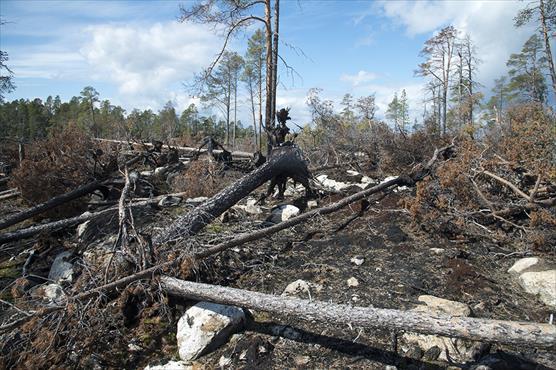Finnish, Swedish and Russian researchers highlight the ecological effects of forestry in Fennoscandia in five review articles published in the journal Ecological Processes. The summarized research suggests that the amount of dead trees in commercial forests is not sufficient for the species requiring decaying wood. To improve the situation, the researchers propose retaining considerably more dead trees and old trees in felling, increasing the number of retention trees and prescribed burning, and improving the forest certification system.

Wildfire forest on north Finland. Photo Riku Lumiaro.
Dead trees should be retained more accurately in felling and more should be produced
In their study, Research Professor Matti Koivula and Research Scientist Ilkka Vanha-Majamaa from the Natural Resources Institute Finland (Luke) reviewed the results of 22 Fennoscandian experimental set-ups on the effects of felling. The average volume of dead trees in commercial forests is only a few cubic metres, and the results show that especially coarse woody debris in advanced stages of decay is susceptible to destruction in connection with forest regeneration.
According to Koivula and Vanha-Majamaa, Finland could take inspiration from the many measures implemented in Swedish commercial forests and leave more wood in forests in connection with felling, as in Russia in the past, to ensure sufficient decaying wood in the future as well. They propose both short-term and long-term responses to halt the loss of biodiversity in forests.
“All dead trees— excluding concentrations at high risk of European spruce bark beetle infestations (more than 10 cubic metres of damaged, weakened or fresh windfalls of spruce trees per hectare) — should be retained in felling and more should be produced, for example, by creating artificial snags, as Sweden has done for a long time and now also Finland to some extent. Artificially created snags benefit endangered species, although their species composition differ slightly from the species in naturally died trees”, Koivula says.
The summarized studies suggest that all deadwood concentrations, apart from those at high risk for bark beetle infestations, should be retained in connection with forest management activities. The destruction of individual dead trees in felling and harvesting of deadwood as energy wood should also be avoided. According to Professor Lena Gustafsson from the Swedish University of Agricultural Sciences (SLU), in addition to retaining decaying wood, biodiversity can be supported cost-effectively by not harvesting defective or economically insignificant trees, saving valuable habitats from felling, and concentrating biodiversity efforts. This would mean, for example, larger but less densely concentrated retention patches.
PEFC forest certification standard needs to be developed to better reflect biodiversity
A large number of studies show that the retention tree requirements in Finland (currently ten trees per hectare, minimum DBH ≥ 10 cm), which are mainly based on the Program for the Endorsement of Forest Certification (PEFC) forest certification standard, are too low to maintain forest biodiversity. Thus, PEFC does not meet the ecological objectives set for it.
“Despite this, the ecological criteria of the certification system have been weakened in the updating rounds of the PEFC standard”, says Timo Kuuluvainen, Lecturer in silviculture at the University of Helsinki.
On average, the total volume of living retention trees in harvested sites is less than three cubic metres per hectare. The reviewed research shows that such low levels of retention trees are not enough to increase, or even to maintain, the volume of dead trees in commercial forests. In Sweden, as much as 11% of the forest area is not treated in connection with regeneration felling. In Finland, the corresponding figure has generally been less than 3% per year.
According to the raw material statistics from Luke, up to half a million cubic metres of forest chips used by heat and power plants have been produced from large-sized timber, a large proportion of which is from dead trees.
“This amount is larger than the volume of live retention trees left in clear cutting in non-industrial private forests each year, 0.3 million cubic metres”, says Petri Keto-Tokoi, Lecturer in forest ecology at Tampere University of Applied Sciences (TAMK).
This is despite the fact that the PEFC criterion on energy wood clearly obliges forest owners not to damage large decayed trees. Furthermore, in harvesting operations carried out on unfrozen soil, more deadwood is destroyed than in winter felling. If mild winters become more common, as seems to be the case at least in southern parts of the Fennoscandian countries, the authors anticipate that felling activities will further drive the destruction of decayed trees and loss of biodiversity.
Based on the summarized results, the minimum amount of retention should be between 5% and 10% of the total volume of the growing stock, and the minimum diameter of living retention trees should be re-established at 20 cm.
Prescribed burning should be increased
Although increasing prescribed burning in order to maintain diversity has been recommended for a long time, the size of the area burnt has diminished. According to the authors, prescribed burning of stands with large number of retention trees should be re-introduced in state-owned commercial forests, and the support scheme for private forestry should be reformed to encourage forest owners to carry out prescribed burning in connection with their forest regeneration activities.
“The ongoing updates of certification systems could also help to promote prescribed burning”, says Henrik Lindberg, Principal Research Scientist at Häme University of Applied Sciences (HAMK).
Pekka Punttila, Senior Researcher from the Finnish Environment Institute (SYKE), is concerned about the decline in habitats and species dependent on wildfires, and hopes that more conservation areas could be established in wildfire areas:
“It would also be important to increase restoration and nature and forest management-based burning, as has been proposed in recent assessments of threatened species and habitat types”, Punttila says.
Read more on Natural Resources Institute Finland (Luke) pages